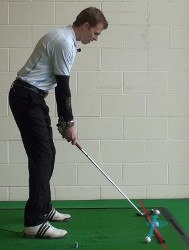
Inside-to-Out Swing Path
An inside-to-out swing path is a term used in golf to describe the path that the clubhead takes during the downswing. It refers to a swing where the clubhead travels from inside the target line to outside the target line as it makes contact with the ball. This swing path is commonly associated with a draw or a fade shot.
- A swing path refers to the direction that the clubhead is moving as it strikes the ball. This is an important factor in determining the direction and trajectory of the shot.
- The target line is an imaginary line that runs from the target to the ball. The swing path can be observed in relation to this line.
- An inside-to-out swing path can be beneficial for several reasons:
- Increased Distance: An inside-to-out swing path promotes a more powerful and efficient transfer of energy from the club to the ball. This can result in increased distance off the tee or iron shots.
- Draw or Fade Shots: An inside-to-out swing path is often associated with shaping shots, particularly a draw or a fade. A draw is a shot that starts to the right of the target (for a right-handed golfer) and gently curves back to the left, while a fade moves in the opposite direction.
- Reduced Slice: For many amateur golfers, the slice is a common problem. An inside-to-out swing path can help reduce or eliminate the slice by promoting a more square impact position at contact.
While an inside-to-out swing path can be advantageous, it also requires precise timing and mechanics to execute correctly. Here are some tips to help you achieve this swing path:
- Ensure a proper setup: Start with a square stance and align your body and clubface with the target line.
- Focus on the takeaway: During the backswing, maintain a smooth and controlled motion, keeping the club on the correct plane.
- Transition smoothly: As you start your downswing, aim to transition from the backswing to the downswing in a fluid motion without any sudden changes in tempo or path.
- Keep the club on the inside: During the early stages of the downswing, focus on keeping the clubhead on the inside of the target line.
- Rotate hips and release the club: To ensure the club follows an inside-to-out path, it's important to initiate the rotation of the hips towards the target and fully release the club through impact.
- Practice and repetition: Achieving an inside-to-out swing path requires practice and repetition. Film your swing or work with a golf professional to analyze your swing path and make any necessary adjustments.
In conclusion, understanding and implementing an inside-to-out swing path can help improve your golf game by increasing distance, shaping shots, and reducing the slice. Consistent practice and attention to the mechanics of your swing will aid in achieving this desired swing path.





